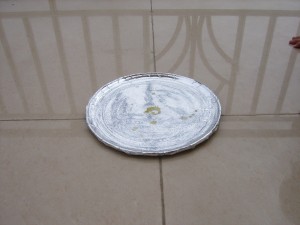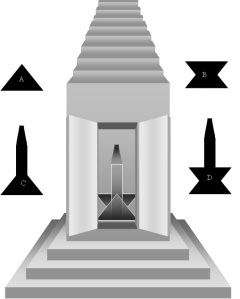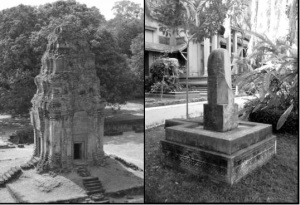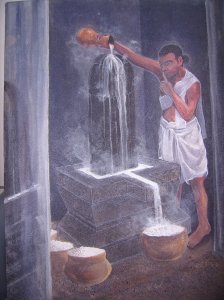Posts Tagged Angkor
Sun Disks of Antiquity Links
Posted by secretsofthesunsects in Uncategorized on June 9, 2011
These links support the view expressed in The Ancient Solar Premise that sun dishes were common in antiquity. Some are imitations of the original devices, but the majority work at least as fire-starters. Some just link to images from the various cultures of the dishes being used or where they were worn. Once the construction technique outlined here is accepted as the method for making Burning Mirrors, these ‘ceremonial’ and vanity objects take on characteristics of devices.
Please feel free to add links to photos of similar dishes in the add a comment section below. Of particular interest would be the Atens/Sun dishes of Egypt, The Americas and the small dishes of the Neolithic peoples, the older the better.
South Asia
In South and South East Asia these sun dishes are so common, they can readily be found and bought in any decent antiques market. They barely rate a mention in the museums, there are so many of them. Most have had the concentric circles that grace their concave sides polished away so ancients can look at themselves in an enlarged form. Siva discs are a standard item in the hands of any statue of Vishnu.
Here are some from a museum with and without the concentric circles. The problem with this vanity mirror idea is that the blob in the center or the concentric circles makes the dishes useless as cosmetic mirrors, unless of course they did not like to look at their noses.
Here is an example with the surface recovered showing where the original circles have been filled and polished over. After coating with a reflective layer, this small dish still has a focal length of over five feet. This is more than adequate to start a fire in the kitchen.
Other examples without a shiny coating.
EGYPT
Horus who emits rays of Datura from the sun disc on his head. Nice picture
Falcon God with a sun dish on his head
Bovine form of god with sun dish on her head
Egyptian Objects
Crocodile & Scorpions adorned with sun discs
Large bronze of Isis wearing a sun dish
http://t0.gstatic.com/images?q=tbn:ANd9GcTWkQI8GMSu0HD13mgbJltcuKSGAfLYuMPncsdDi98aKihnTV07
http://t0.gstatic.com/images?q=tbn:ANd9GcSOJqhVHkIByA9izCdHHJa1wYIx5iaqRyRlE7oaZgyWBA7Y310
Lioness adorned with a sun dish
http://t2.gstatic.com/images?q=tbn:ANd9GcTCTGXqekPHGlEueXsyGUoZSRtstrAirOrQSxQqs0XA-iiipagvTQ
*Egyptian Bronze snakes supporting a lovely sun dish
http://t0.gstatic.com/images?q=tbn:ANd9GcQ3-Lo_OiaciSTgcNvkL_cKFUJbpifoUTys7DuoyAjBja9Y1pe8
*Exquisite gold Horus with actual sun dish on head
Hathor stonework with sun dish on head
http://t1.gstatic.com/images?q=tbn:ANd9GcQGsJT-QKbP3Og6Acu1Gy0alabcJwEp1mm3FKM_i_2rjLawAOxvnA
Egyptian sun disk/vanity mirror
Egyptian Bronze disk with Hathor
Egyptian dish with bronze handle
Egyptian Solar Weapons
*Helmets with solar dishes attached
Fresco showing mycenei warrior, sea people
Some other ancient warriors carrying reflective shields and sun dishes on their head into battle.
Babylonian
Bronze mirror disk with bull carving
http://t3.gstatic.com/images?q=tbn:ANd9GcT1nyamRIxiVaO8witwUvSByQmRQNUANrdPPcVJLxM01O9x7bow
BRONZE AGE
Incredible Bronze Age model of a chariot from Denmark with a Sun Disc on the back.
Other side of the same chraiot
http://t1.gstatic.com/images?q=tbn:ANd9GcRRuwxjtiABYPzg1xkRRLBQ50hZpFvSGp3WnUCimNJLKLwrylBnqQ
Bronze Age Dane with sun dish for starting fires
Bronze Age Dane with shield plus two smaller sun dishes, amongst other valuables
http://t2.gstatic.com/images?q=tbn:ANd9GcQXBbZz3tohBsIUnzFHG7PTF8oxgtidlIy_dmtV76vd8QHJr6mqNQ
Wiltshire bronze age woman’s fire starting amber mirror
Bronze Age Georgian Woman’s fire starting mirror, looks to have been turned into a trinket.
Small welsh sun dish from the Bell beaker people, surprisingly similar to the Siva discs
Celtic sun dish /vanity mirror beautiful example
Massive sun shield from sweden
AMERICAS
Gold armour, a little heavy unless it provides another function in battle
Gold armour? Who would you want to kill and plunder?
Chinese
Couple of nice Hang dynasty bronze mirrors
http://t2.gstatic.com/images?q=tbn:ANd9GcQTjRgJ9tsGMdo8VaZLfnCqCh4BiomeJ1D0nkhULJWKorTYHfAc
http://t1.gstatic.com/images?q=tbn:ANd9GcSDQx9IlrDP5Td3NbmoIWTECn4q33hpQyi4okqT4UkkV23GtxVQ
Hand mirror Chinese, Ming dynasty bronze
http://t2.gstatic.com/images?q=tbn:ANd9GcQA_AG0vXeh_rrB7xtJtQJq9WXmGjNRmcpEfQL_o3yE8TulmKE8
Copper drums with sun motif on the solar disc, common in SW china and SE Asia.
SouthEast Asia
Sun dish drums from Vietnam, Cambodia and South china generally have suns on the outer face. When the drum is turned over and pointed at the sun, it will cook food! If the drum is banged it will make a rather tinny drum noise.
http://t0.gstatic.com/images?q=tbn:ANd9GcSgOxvT2tXH5WUkLXf2ovjJrW66fa1UVA7T1vD3jZ_ZRmeYQ7X5jw
Vietnamese mirrors, with decal or spot in the center making them useless as vanity mirrors
Vietnamese One with the phoenix on the back
http://t2.gstatic.com/images?q=tbn:ANd9GcTTNcpT-yt3tRq9F2OT7alS3UIKkRBKSn4alNCZR-k71Pf4fanm8Q
The Ancient Solar Premise
Posted by secretsofthesunsects in Articles on June 6, 2011
The Ancient Solar Premise is simple, the ancients were originally using the sun, not idolizing it. There are two key devices that support this view, parabolic sun dishes and structures that collected and stored solar energy in large stones. These technologies allowed the ancient world to thrive for centuries with the sustainable energy of the sun. The solar religions followed as the importance of the devices grew and the processes became ritualized. Eventually the solar power was replaced by fossil fuel and the historians were left with the religious view. The exposition along with archaeological and textual support can be found in the ‘The Ancient Solar Premise’
The ease with which sun dishes could be made to concentrate sunlight by thousands of orders is outlined in the paper ‘The Math Behind Burning Mirrors’. This tool had a myriad of uses and explains a variety of ancient relics. The dishes create such high temperatures that they challenge the conventional views on the origins of metallurgy, fine stonework, astronomy and ancient weaponry. Whilst these tools are found in many of the ancient sun cultures, the focus here is the group of solar buildings that stand out as a map of the sun cults.
Sun Temples have many names throughout the world, they are identified by the local solar deity and are variously dedicated to Ra, Siva, Brahma, Baal, Bel, Re, Marduk, etc. Often they are described generically as Wats, Sanctuaries, Shrines or Temples, but each retains the same facets and will be referred to by the functional name ”solar chambers”. The solar chamber is one of the most common legacies from a number of ancient civilizations. Their importance is considered to be ceremonial, however the following summary illustrates that each variant was functionally important to the constructors.
The Solar Chamber
Below is a generic Asiatic ‘shrine’, usually described as a sanctuary. Each of these solar chambers sat on a raised platform and contained a simple dark stone behind two large shiny flanking doors, which pointed towards the sun. This is a surprisingly common building over the continents and eras. The vast majority number in the tens of thousands and sit alone on small platforms or sunny hillsides. There were many thousands more that sat on the renowned stepped pyramids found in cultures all over the globe.
The diagram shows the classic Brahman design with a yoni and linga (D) sitting in the center of the sealed chamber with two reflective doors flanking the long doorway. Around the chamber are alternative dark stone absorbers found in other styles of solar chamber. Sometimes just a plinth or altar stone (B) is found within the chamber. In these cases, the chamber height is reduced along with the doors and doorway. Often there were just obelisks or pillars sitting atop of truncated pyramidal plinths (C). This design was sometimes reduced further to just the pyramidal stone (A) and an appropriate chamber.
The chambers were made from local materials and dealt with the regional weather. In cool climates, the chambers generally had much thicker walls. In the most primitive cases, the stones were held deep within structures piled high with earth. In rainy climates, the buildings had suitable protective roofing. In hot dry locales, where rain was not an issue, the altar stones could be left exposed to the elements without even a cursory housing. Brick, stone, wood or mud chambers can be identified throughout the ages along with combinations of them. Each acted as an insulator, able to retain the solar heat within the chamber overnight or longer.
The reflective doors have usually long since been destroyed, but the original substantial housings for the hinges can still be seen. The modern copies of these structures retain the metal casing for the doors and shiny metals are still used. Gold paint has typically replaced the original metal, but the design is still there in essence. The ancient metals used follow the development of metallurgy throughout the ages. In the Americas, there are reports from the conquistadors of brilliant gold doors on the sanctuaries shining in the morning sun. In Africa and Asia, brass/bronze seems to have been a common metal along with silver and gold leaf. Even tin appears to have been used, though maintenance did not make it a popular choice. The skins of the doors were covered in whichever metal was commonly found in the mirrors of the specific culture.
Solar Alignment
Without exception, these structures were dedicated to the respective solar deities and faced the point where the stone gained maximum solar exposure. In the tropics, this was achieved by pointing a single doorway to either the rising or setting sun. Often the six monthly monsoonal rains fell like clockwork in the afternoon, so there was little point having a door facing west. Sophisticated re-alignments took into account the monsoon patterns and adjusted the direction toward a point just off due east. This optimized the chambers for solar energy collection, since there was no point trying to absorb sunlight through clouds and rain.
More commonly, there were two doorways, one pointed east and one west. These provided more chances to collect sunlight in the morning and afternoon. This style was invariably aligned due east to west. Weather permitting, it allowed for more sunlight to be absorbed than the single door version.
Solar chambers further from the equator had southern and northern doorways added that gained solar energy from the low midday sun in the summer/winter. Again, the chambers were aligned east to west and had one door pointing to each direction of the compass. In the far north, the extreme cases had eight, sixteen or thirty-two doors. This is a controversial aspect of the basic solar premise, which rests much better under the Grand Ancient Solar Hypothesis.
Detailed calculations confirmed by experiment, show that a single solar chamber can collect and return up to a hundred kilowatts of energy a day. There is a useful range of temperatures delivered by the system, which depended on the needs of the users. This relatively low cost clean energy provided a survival advantage to the ancient sun cults beyond that of the fossil fuel cultures.
Sun Chamber Uses
To use the solar chambers the operators just opened the doors when the sun was in front of them. At all other times the doors were tightly closed. The direct and reflected light heated up the stone to temperatures able to cook food, boil water and dry crops. The initiation of a chamber stone could take days because they were large, but this added resilience with a useful heat repository. When the chamber doors were shut, the temperature rose to something close to that of the central stone. With this simple operation, the ancients were able to carry out the following tasks.
- Fry Eggs, the eggs were cracked and left on the hot stone surface.
- Sere Meats, the flesh was tossed on the surface of the hot altar stone.
- Boil Water, the water was poured onto the obelisk, then warmed to boiling point as it ran down and flowed out of the spout on the base.
- Cook Rice & Soups, the boiled water was collected in rice pots and then left inside the chamber slowly cooking the produce.
- Dry Crops, the produce was left around and above the central stone until it dried.
- Bake Breads, the dough was left on racks of trays in the hot chamber
In many of the oldest cases, it is difficult to know exactly which function an individual chamber was assigned. However, in recent examples, much of the practical paraphernalia has been found and texts allude to various utile items. The picture of a novice priest pouring water onto a yoni linga combination is the most common Asiatic use. Boiled water is important for health or cooking and requires large quantities of fuel to produce. Brahman shrines often had water in sacs suspended above the heated stone, which dropped onto the stone where it was funneled to collection pots.
The same chamber could be used to dry crops or cook bread when racks were placed above and around the stone. Most of the time the sanctuaries were allotted a single foodstuff since it is not so wise to mix meat and fish for example. There is a great deal of archaeological evidence in The Ancient Solar Premise that fully supports this idea. However, it is only the tip of the iceberg, since there are many more cultures to review under this scheme.
The design turns out to be one of the most efficient ways to collect and store solar energy given the constraints of antiquity. Indeed an abridged version of the ancient solar cooker is finding uses today in poor rural communities throughout Asia. The robustness, low cost, high-energy returns and storage that made this solar chamber popular in antiquity are proving just as useful today.
The Widespread Use of Solar Chambers
The variety of solar chambers across ancient civilizations falls under the wider model. However, a few brief examples should illustrate the prevalence of solar technology in the ancient world. (The letters indicate the style of stone absorber used from the diagram above.)
- A Brahman shrine held the classic black yoni and linga stone design within the sanctuary (D). Later the Hindus changed the stone color to white in order to cool the chambers down so they could make merit within them.
- A Vedic shrine/sanctuary sometimes contained the flat altar, pillar or both combined (D, B). Small altar versions were used in the home, whilst larger ones were built for communities. Ancient Vedic texts refer to the complex formulas they needed to calculate the right sized stones.
- A classic temple of Ra/Re held a dark pillar on top of a truncated pyramid. Sometimes it just contained the pyramidal stone form (benben stone), but was still a temple of Ra (C, A). Like the Brahma, the Egyptian priests poured liquids onto the shorter hot pyramidal stones and collected it in alabaster pots.
- A Temple sanctuary of Marduk in Babylon held the simple flat altar stone (B). These grand temples, like the Temples of Ra, often housed huge storage chambers for the processed foodstuffs.
- In the Americas, the same flat altar stone combo describes a sanctuary or shrine of Itni (B). In Peru, stones are still found that are identical to the Brahman stones despite the Spanish efforts to destroy them all (D).
- Going back in time, a similar but simpler construct is found in primitive Neolithic ‘shrines’. Here the sanctuary was lower but extended, usually piled with earth and the flat altar stone sat at the back (B). It is often unclear who the god was, but usually it was Baal, Bel or some other ancient sun god. The use in the colder climates was primarily, but not exclusively, to aid in domestic heating.
- Ancient Asian Pagodas were made of wood on several tiers and housed a dark obelisk or altar at the ground level (B, D). The venting above, clearly made these structures useful in drying crops. This adjustment to the normal sealed chambers was found in many farming communities where solar drying was used.
There are many more examples…
Conclusion
The outline above is a gross oversimplification of the Ancient Solar Hypothesis. The details of the materials, geometry, energies and textual support for the uses can be found in The Ancient Solar Premise‘. There is much more compelling evidence in the finer aspects of the solar premise. Some may debate individual details, but when people see and feel these buildings working as intended, arguments evaporate as fast as water on an overheated plinth.
When these simple temples clearly have their origins in a functional role, questions are raised about the nature of cultural development. The emphasis switches from people building ”shrines” for worship, to citizens turning to the sun for its utility. The rise of religions and the reassignment of the structures to ceremonial roles is a lengthy field of research. The impact this had on the routines and running of a culture are curious. Many of these strands are explored in the book, though it is impossible to contemplate them all.
The result is a reframing of much that is believed about the ancient world, in both technological and cultural terms. The religious and symbolic fancies that followed the useful functions of the sun devices can be put into perspective. Maybe historians can dwell on the utility and foresight of the ancients rather than assigning them a mind set more akin to 17th century academics. Ultimately, the aim is to inspire people to take a leaf out of the ancient’s manual for living and turn fully to the tenets of sustainable energy. This really would be a great gift from antiquity.
The Grand Ancient Solar Hypothesis
Further to the basic concept above, there is the extension to the Grand Ancient Solar Hypothesis. This scheme shows how hundreds if not thousands of these structures were arranged in discrete areas to create the great solar industries of antiquity. There is no other way to describe the ancient pyramidal processing centers that dealt with thousands of tons of crops and foodstuffs every year. The way the ancients laid out the chambers leaves one in no doubt as to their goals. This is a precedent that the modern industrial machine would do well to follow.
The temporal and geographic extents to which these principles were used adds further grand dimensions. The simplest styles underpinned the Neolithic cultures within the barrows containing altar stones. Whereas the grand stone circles, possess such an exquisite form of the geometry that one has to feel it working in cooler climes to believe it. This pushes the premise so far back in time that it underpins the emergence of civilized man. The use of solar energy on a grand scale runs through the civilizations of Babylon and Egypt, dips with the Greeks and Romans and then emerges in its full glory within the Angkorian and Aztec cultures. This is such an incredible run that it makes us moderns look like smoke addicted fools.
The existence of the small and large structures on all but one continent leave no doubt as to the nature of the successful cultures, they were solar powered. The basic rules above were applied on such a scale that it is no surprise that the concept has been overlooked by scholars. Some of the grandest structural legacies of antiquity were not the result of egotism or religious zeal, they were industrial expressions of the solar premise. Many of these iconic constructs are touched on in The Ancient Solar Premise, but it is certain more will fall under solar umbrella as the theory is tested with reconstructed sites, tools and techniques.
Non-fiction Books & Research by Christopher Jordan
Subjects Covered in The Secrets of the Sun Sects
Posted by secretsofthesunsects in Uncategorized on March 27, 2011
The Secrets of the Sun Sects covers a large number of areas,
Here is a summary
THE SUN DEVICES OF ANTIQUITY
Burning Mirrors
1. Burning Mirrors – an overview of what parabolic mirrors are able to do
2. Ancient Mirror Math – The simple math & geometric solution to Archimedes burning mirror problem
3. Dish Construction – How to make 10Mw/Sqm solar concentrators in antiquity or a garage
4. A New History of Mirrors – The implications for Greeks, Egyptians, Alchemy, Incans and more.
5. Star Wars – The use of burning mirrors on the ancient battlefields
The Sun Temples
6. The Sun Temples – A description of a solar chamber, energy and usage across the ancient world
7. Temple Mountains – The arrangement of sun chambers on step pyramids builds to ancient solar industries
8. Temple Distribution & Climate – The rationale for the solar chamber variances across the globe
9. Stone Circles – The solar premise applied to neolithic stone circles
10.Conclusion – The ancient world was powered by sunlight
THE SUN DEVICES
11. Solar Tools – A guide to making powerful sun dishes today
12. Food & Water – Using ancient techniques to fry, boil and cook at home or in the factory
13. Climate Control & Power – Using old technology to cool the home and produce power 24/7
14. Materials & Crop Processing – Solar Recycling, refining, materials synthesis & agricultural applications
15. Lost Techniques of the Solar Artist – Stone cutting, finishing, ceramics & gems
16. Miscellaneous Devices – How to make & use powerful Ancient Telescopes
17. Commercial Concerns – Benefits & reservations in the commercial environment
THE SUN SECTS
18. Revising the Past – Adding the Ancient Solar Sects to the record
19. The Inception of Civilization – Did civilization start with a hot black stone or fire?
20. European Sun Sects – The emergence of neolithic solar powered cultures
21. The Egyptian Sun Sects – The utility of sun gods & their temples/tools
22. Egyptian Priestly Orders – The skills hierarchy of the ancient solar orders
23. The Demise of the Sun Cults – The reasons for failure
Modern Solar Sects
24 The Transition Cultures – The switch from solar energy to sun worship
25. Eastern Religions – The Solar Cult legacies of the East
26. Western Religions – The Solar Cult legacies of the West
27. Miracles of Light – Biblical refs to solar devices
28. The Prophecies – 3 Ancient Prophecies reinterpreted
SUNNY FUTURES
29. A Bright Future – Some very optimistic outlooks
APPENDIX
A. Missing Greek Math – Tables of Hipparchus & Archimedes
B. The Power of Spherical Mirrors – The full math proof behind burning mirrors
C. Thermal Properties of the Sites – Detailed energy calculations for sun temples and stones
D. Projects – Completed and ongoing projects, High tech, low tech and historical



































